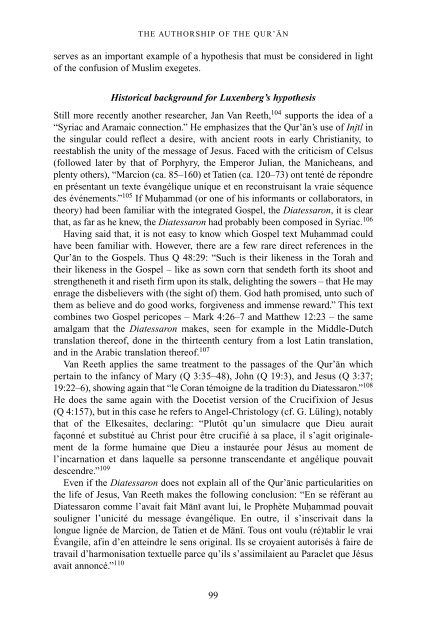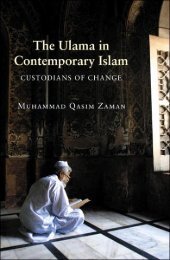The Qur'an in its historical context (pdf - Islam and Christian-Muslim ...
The Qur'an in its historical context (pdf - Islam and Christian-Muslim ...
The Qur'an in its historical context (pdf - Islam and Christian-Muslim ...
You also want an ePaper? Increase the reach of your titles
YUMPU automatically turns print PDFs into web optimized ePapers that Google loves.
THE AUTHORSHIP OF THE QUR’AN<br />
serves as an important example of a hypothesis that must be considered <strong>in</strong> light<br />
of the confusion of <strong>Muslim</strong> exegetes.<br />
Historical background for Luxenberg’s hypothesis<br />
Still more recently another researcher, Jan Van Reeth, 104 supports the idea of a<br />
“Syriac <strong>and</strong> Aramaic connection.” He emphasizes that the Qur’an’s use of Injil <strong>in</strong><br />
the s<strong>in</strong>gular could reflect a desire, with ancient roots <strong>in</strong> early <strong>Christian</strong>ity, to<br />
reestablish the unity of the message of Jesus. Faced with the criticism of Celsus<br />
(followed later by that of Porphyry, the Emperor Julian, the Manicheans, <strong>and</strong><br />
plenty others), “Marcion (ca. 85–160) et Tatien (ca. 120–73) ont tenté de répondre<br />
en présentant un texte évangélique unique et en reconstruisant la vraie séquence<br />
des événements.” 105 If Muhammad (or one of his <strong>in</strong>formants or collaborators, <strong>in</strong><br />
theory) had been familiar with the <strong>in</strong>tegrated Gospel, the Diatessaron, it is clear<br />
that, as far as he knew, the Diatessaron had probably been composed <strong>in</strong> Syriac. 106<br />
Hav<strong>in</strong>g said that, it is not easy to know which Gospel text Muhammad could<br />
have been familiar with. However, there are a few rare direct references <strong>in</strong> the<br />
Qur’an to the Gospels. Thus Q 48:29: “Such is their likeness <strong>in</strong> the Torah <strong>and</strong><br />
their likeness <strong>in</strong> the Gospel – like as sown corn that sendeth forth <strong>its</strong> shoot <strong>and</strong><br />
strengtheneth it <strong>and</strong> riseth firm upon <strong>its</strong> stalk, delight<strong>in</strong>g the sowers – that He may<br />
enrage the disbelievers with (the sight of) them. God hath promised, unto such of<br />
them as believe <strong>and</strong> do good works, forgiveness <strong>and</strong> immense reward.” This text<br />
comb<strong>in</strong>es two Gospel pericopes – Mark 4:26–7 <strong>and</strong> Matthew 12:23 – the same<br />
amalgam that the Diatessaron makes, seen for example <strong>in</strong> the Middle-Dutch<br />
translation thereof, done <strong>in</strong> the thirteenth century from a lost Lat<strong>in</strong> translation,<br />
<strong>and</strong> <strong>in</strong> the Arabic translation thereof. 107<br />
Van Reeth applies the same treatment to the passages of the Qur’an which<br />
perta<strong>in</strong> to the <strong>in</strong>fancy of Mary (Q 3:35–48), John (Q 19:3), <strong>and</strong> Jesus (Q 3:37;<br />
19:22–6), show<strong>in</strong>g aga<strong>in</strong> that “le Coran témoigne de la tradition du Diatessaron.” 108<br />
He does the same aga<strong>in</strong> with the Docetist version of the Crucifixion of Jesus<br />
(Q 4:157), but <strong>in</strong> this case he refers to Angel-Christology (cf. G. Lül<strong>in</strong>g), notably<br />
that of the Elkesaites, declar<strong>in</strong>g: “Plutôt qu’un simulacre que Dieu aurait<br />
façonné et substitué au Christ pour être crucifié à sa place, il s’agit orig<strong>in</strong>alement<br />
de la forme huma<strong>in</strong>e que Dieu a <strong>in</strong>staurée pour Jésus au moment de<br />
l’<strong>in</strong>carnation et dans laquelle sa personne transcendante et angélique pouvait<br />
descendre.” 109<br />
Even if the Diatessaron does not expla<strong>in</strong> all of the Qur’anic particularities on<br />
the life of Jesus, Van Reeth makes the follow<strong>in</strong>g conclusion: “En se référant au<br />
Diatessaron comme l’avait fait Mani avant lui, le Prophète Muhammad pouvait<br />
souligner l’unicité du message évangélique. En outre, il s’<strong>in</strong>scrivait dans la<br />
longue lignée de Marcion, de Tatien et de Mani. Tous ont voulu (ré)tablir le vrai<br />
Évangile, af<strong>in</strong> d’en atte<strong>in</strong>dre le sens orig<strong>in</strong>al. Ils se croyaient autorisés à faire de<br />
travail d’harmonisation textuelle parce qu’ils s’assimilaient au Paraclet que Jésus<br />
avait annoncé.” 110<br />
99



